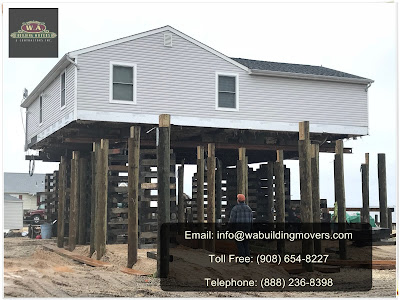Many people live near water, whether it be fresh water zones that are sometimes prone to floods, wetlands and natural protection areas, or low-bank sound or Oceanside properties. In many of those cases, there is a need to move a house back from the potential high-water zones or to lift your house.
Lifting these homes that already have had a flooding condition will prevent future losses. Lifting a home in these areas is also a preventative measure so that, if a flood occurs, the home will be safe from the flooding. Mitigation through house lifting can also be beneficial in dealing with the potential effects of climate change including sea level rise and increased flooding.
Whether it’s to avoid flood damage or to add another story below your house, more and more homeowners are raising their houses. Yes, the average cost to raise a house is not cheap, but it’s a project professionals can accomplish in just a few days. Of course, there are plenty of factors that can increase or decrease that cost, so doing your homework can definitely help you out in the long run.
The costs to raise your home above the base flood elevation can be budgeted anywhere from $30,000 to over $100,000. This is a big range because so many details are needed for accurate pricing of this type of project.
There are many factors that go into pricing, which include, FEMA elevation and zone. This confirms what type of foundation is required. V zones require pilings, so a block foundation would not work in this situation. To raise a New Jersey house onto pilings your home would need to be moved off the current foundation to allow a crane to come in and pound in wood pilings.
If that is not possible due to limited space, your home can still be raised, but the process gets a little more complicated and costly. In cases like this, helical piles would need to be used in lieu of conventional wood pilings. Houses on a slab can create even a bigger challenge, as there are no floor joists in your home. While it is still possible to raise a house on a slab, it can get very costly to raise this type of structure.
Trees and other bushes & flowers, so this cost needs to be factored in as well as the cost of replanting the trees and/or replacing any landscaping when the lift is completed. Raising your home’s foundation also comes with a few “hidden costs.” You will need to disconnect all power, plumbing, and phone service to your home during the construction process, and then turn it all back on after completion.
You’ll need a structural engineer to sign off on your plans in order to obtain the permits. There will also almost definitely be repair work needed after the home has been lifted, due to natural inevitable damages. There will likely be hairline cracks in the plaster that need to be fixed, as well as repairs to the exterior if the siding has to be removed to install required hurricane strapping.
In summary, House Raising is an intensive process performed for a variety of structural, safety and aesthetic purposes.
The average Cost to Raise a House is not cheap, but it’s a necessary investment to keep your home safe from flooding. There are many factors that can increase or decrease that cost, so doing your homework can definitely help you out in the long run.






